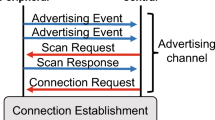Abstract
The emergence of wireless and personal communication networks has brought random access protocols for packet radio networks back to the research forefronts. Most such protocols are based on the ever popular ALOHA protocol. Unfortunately, this protocol is inherently unstable and requires sophisticated schemes to stabilize it. Another class of random access schemes, called limited sensing or stack algorithms, has been proposed that is stable and allows for the dynamic incorporation of new stations into the network. In this paper, we will review the simple to implement n-ary stack algorithm, and we will study its performance under various system parameters in the presence of capture, and also in the presence of feedback errors. Finally, we will investigate its maximum system throughput under various traffic generation processes.
Similar content being viewed by others
References
D.J. Aldous, Ultimate instability of exponential back-off protocol for acknowledgement-based transmission control of random access communication channels, IEEE Trans. Inform. Theory 33(2) (1987) 219–223.
C. Bisdikian, L. Merakos and L. Georgiadis, Stability analysis of interconnected single-hop random access networks, IEEE Trans. Comm. 40(3) (March 1992) 556–567.
C. Bisdikian, B. McNeil, R. Norman and R. Zeisz, MLAP: A MAC level access protocol for the HFC 802.14 network, IEEE Comm. Mag. 34(3) (March 1996) 114–121.
C. Bisdikian, A review of random access algorithms, in: Proc. Internat. Workshop on Mobile Communications, Thessaloniki, Greece (September 19–20, 1996) pp. 123–127.
I. Cidon and M. Sidi, The effect of capture on collision-resolution algorithms, IEEE Trans. Comm. 33(4) (April 1985) 317–324.
G. Fayolle, P. Flajolet, M. Hofri and P. Jacquet, Analysis of a stack algorithm for random multiple-access communication, IEEE Trans. Inform. Theory 31(2) (March 1985).
L.V. Kantorovich and V.I. Krylov, Approximate Methods of Higher Analysis (P. Noordhoff, Ltd., 1958).
R.O. LaMaire, A. Krishna and H. Ahmadi, Analysis of a wireless MAC protocol with client-server traffic and capture, IEEE J. Selected Areas Comm. 12(8) (October 1994) 1299–1313.
P. Mathys and P. Flajolet, Q-ary collision resolution algorithms in random-access systems with free and blocked channel access, IEEE Trans. Inform. Theory 31(2) (March 1985) 217–243.
L.F. Merakos and C. Bisdikian, Delay analysis of the n-ary stack random access algorithm, IEEE Trans. Inform. Theory 34(5) (September 1988) 931–942.
M. Paterakis and Z. Harpantidou, On the random access of packet broadcast channels with Pareto distributed packet inter arrival times, in: Proc. Internat. Workshop on Mobile Communications, Thessaloniki, Greece (September 19–20, 1996) pp. 234–238.
R. Rom and M. Sidi, Multiple Access Protocols: Performance and Analysis (Springer, New York, 1990).
M. Zorzi and R.R. Rao, Capture and retransmission control in mobile radio, IEEE J. Selected Areas Comm. 12(8) (October 1994) 1289–1298.
Author information
Authors and Affiliations
Rights and permissions
About this article
Cite this article
Bisdikian, C.C. The n‐ary stack algorithm for the wireless random access channel. Mobile Networks and Applications 2, 89–99 (1997). https://doi.org/10.1023/A:1013260028354
Issue Date:
DOI: https://doi.org/10.1023/A:1013260028354




